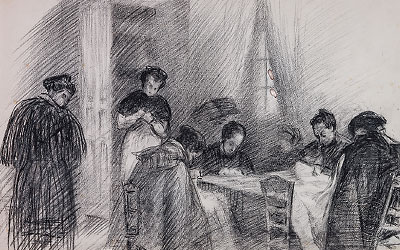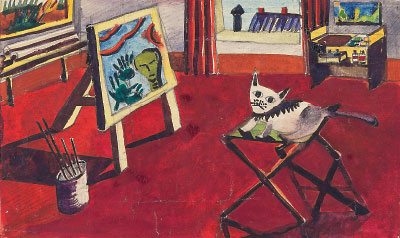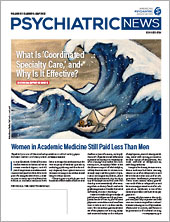I wrote before, in late 2019, about the Musée d’Art et d’Histoire de l’Hôpital Sainte-Anne, known popularly as the MAHHSA. It is a landmark in Paris and an iconic structure among psychiatric hospitals worldwide. I could not ignore its present exposition, “Maisons” (“Homes”), which I visited earlier this year. I take responsibility for my translation of the title/theme, recognizing that the French word could be considered as “houses” or “homes.” MAHHSA’s own description of the exposition convinced me that “homes” is the better term.
The Guide d’Exposition maintained that the collection would evoke a variety of personal images and ideological and architectural conceptualizations of lifestyles. The exhibition would also facilitate metaphorical and imaginary projections about the unreal and the concrete, as well as of true and false memories supported by sensory and bodily experiences. The exposition, divided into four sections, was based on close to 110 works from the museum’s collection and a dozen other additions from contemporary artists.
“La Maison-Hôpital (Home-Hospital)” was the first part of the collection. The guide’s commentary acknowledged that the old term of asylum implied a place of constraint and confinement. In this section of the exhibition, artists depicted a familiar place of residence, signifying that the hospital had evolved into a place of ritualized daily living. Having spent decades discussing the meaning of the psychiatric hospital, I know this recognition of the hospital as home for some people suffering with psychiatric illness distresses many theorists. Nonetheless, it remains reality and deserves memorializing by artists. An untitled 1906 charcoal drawing by H.A.R., one of the earliest artists in the Sainte-Anne collection, is shown at right. In this work, she illustrates women performing the domestic task of sewing. It is hard to determine everyone’s degree of commitment to the activity. However, we know the significance of structured activity in the psychiatric hospital and possibilities of community within a small group. The women’s attire and aesthetics suggest fellowship and dignity. Experts think that the artist was formally trained, with experience in the use of charcoal and sanguine crayons. Her work bears witness to the rehabilitation activity found in psychiatric hospitals at the beginning of the 1900s.
“Vers La Demeure (Towards the Residence),” the second section, marks the movement to becoming sedentary, taking up residence, suspending time. The artists in this group are said to raise questions about the function of the residential space. They provide different notions of size and location of the house and of its integration into surrounding scenery.
In the third section, “A l’Intérieur de l’Intime (Inside the Intimate),” I felt I was inside more private and intimate spaces. As the formal museum description stated, these paintings represented a variety of activities that symbolized rest, leisure, and even boredom. Intimacy was also reflected in special family space or a particular kind of domestic activity. The untitled 1950 crayon-and-gouache work by René Héroult shown at left represents the intimate space of a visual artist. The tools of the craft are present, with a work in progress at the center of the painting. We are left to wonder about the solitary cat as companion. Even so, the colors evince a certain warmth and vibrance.
The fourth section, “Rve d’Habitation (Dream of Home Space),” represents for me the most creative and unexpected contributions to the exposition. The artists constructed their dream of a place to live. The guide booklet drew attention to the tall towers, enormous castles, utopian towns, and presence of machines, while pointing out that some of these imagined spaces seemed uninhabitable.
Leaving the art exhibition, I treasured the experience offered by this unique collection. Sainte-Anne obligated me to mull over what I had just seen. I wanted to know more about the artists and their thoughts about Sainte-Anne. Had it been more a place of healthful restoration than a zone of banishment and invisibility? Had they made a solid connection between place and health? Finally, did their creativity afford them a sense of freedom that conferred dignity and enhanced their well-being? I hope so. There is certainly no doubt that this psychiatric hospital museum is catalyzing thought about its patients’ humanity and our duty to interrogate ourselves about how we interact with them. ■



